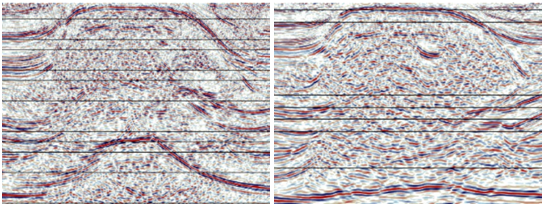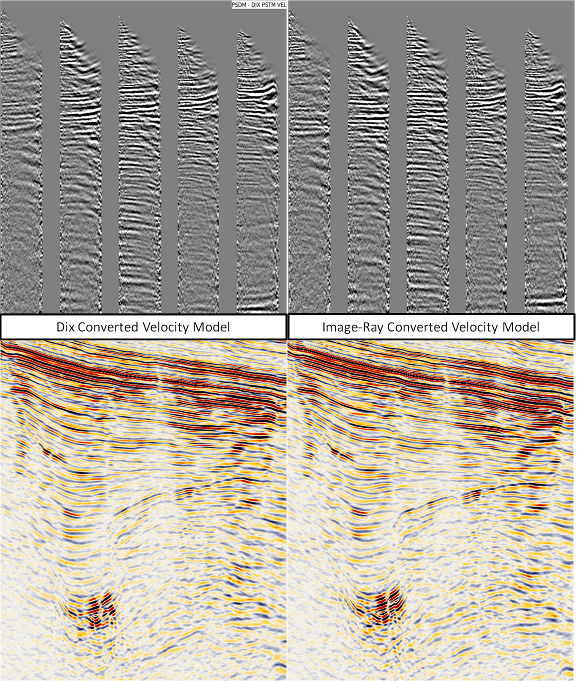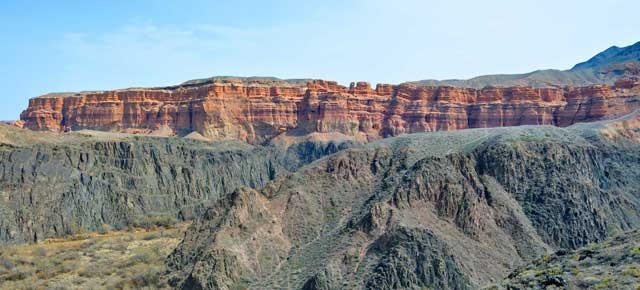Contact
DMT Petrologic GmbH & Co. KG
Karl-Wiechert-Allee 76
30625 Hannover, Germany
Phone: +49 511 5413917
E-Mail: info dmtpetrologic.com
dmtpetrologic.com
Model Building / Depth Imaging
Strong lateral velocity variations associated with complex geological structures require imaging in depth. The benefits are:
Correct lateral positioning
Correct vertical positioning- no pull-up or sags
non-hyperbolic events caused by ray-bending at layer boundaries can be stacked and imaged properly
An accurate velocity model can be derived through the iterative improvement of depth common image gathers (CIG)
3D prestack depth migration feasibility studies can be undertaken here on selected sub-volumes in order to ascertain the effectiveness of the method on the dataset in question. The Paradigm velocity and reservoir modeling suite allows the creation of accurate layered and structural depth models which combine seismic and well information.

- Figure 1: LEFT: Pre-Stack-Time-Migration Image RIGHT: Pre-Stack-Depth-Migration Image
We have broad experience in prestack depth migration for marine, land and transition-zone environments. The example shows a dataset with a salt dome, the fast salt reduces traveltimes for the reflections below it, which can be observed at the time migration result, imaging using a correct velocity model in depth and prestack depth migration solves this issue and furthermore improves the imaging quality of the reflections at the salt flanks.
Initial Model Building
Besides conventional DIX conversion of prestack time migration velocities or the implementation of v0k-laws we can offer 3D NIP-tomography and 3D-Image-Ray-tomography for initial model building. 3D-NIP- and 3D-Image-Ray-tomography convert a RMS velocity field in time, as a prestack time migration velocity field, into a interval velocity in depth. 3D-NIP-tomography uses CRS operators (NIP), while the 3D-Image-Ray-tomography converts the model into depth using the central image raypath. Both methods result in not only vertical conversion of the velocity model ,as it is the case for a DIX converted model, but a conversion which corrects for lateral repositioning of the model due to structure and geological complexity. The results are initial models which much better reflect the geology and less residual error is missing. Therefore, less iterations of velocity model updating is necessary.

- Figure 2: LEFT: Pre-Stack Depth Migration using DIX converted velocity model RIGHT: Pre-Stack Depth Migration using Image Ray converted velocity model
Velocity Model Building
Velocity model building is the most important success factor for imaging projects. All available geological information has to be included in the starting model which is then interactively improved until the common image gathers are flat. Velocity updating involves picking the residual moveout, calculating the ray paths for each picked event through the velocity model then performing a tomographic inversion that modifies the velocity field in order to eliminate the residual moveout along the ray paths.
As we use the Paradigm imaging suite we can either iterate a isotropic velocity model until we achieved complete gather flatness. An anisotropic model can then be created by matching the seismics with well markers for the delta computation and picking the epsilon model interactively by flattening the gathers after migration with the velocity model and delta only. Alternatively we can build an initial anisotropic velocity model and topographically update all involved models simultaneously.
Anisotropy
We can handle all common anisotropic cases. VTI models corrects for a vertical anisotropy which is present as soon as we have a layered medium with changing velocities. VTI assumes a horizontally layered earth whereas TTI accounts for dipping layers. HTI anisotropy is the effect when a ray travels faster in a horizontal direction, as it is the case in fractured shales for example. VTI and HTI can be combined to build a orthorhombic anisotropic model.
Migration algorithms
Kirchhoff migration is the standard for depth imaging in the seismic industry for years. Our Kirchhoff depth migration software is reliable and fast. Besides Kirchhoff we can offer Paradigms CRAM (Common Reflection Angle Migration) - an advanced beam migration and the full azimuth Earth Study 360 migration. For very complex geology with complex ray-pathes we recommend a migration of the final velocity model using a Reverse Time Migration. We have successfully conducted 3D depth imaging using RTM up to 90 Hz.
